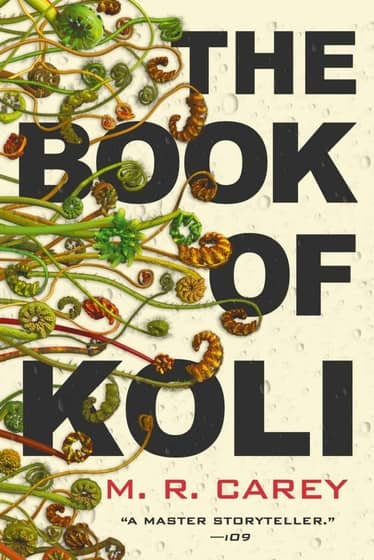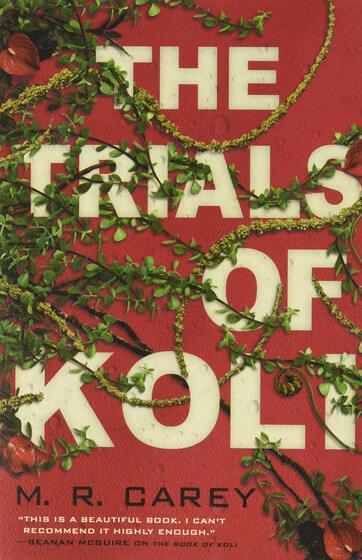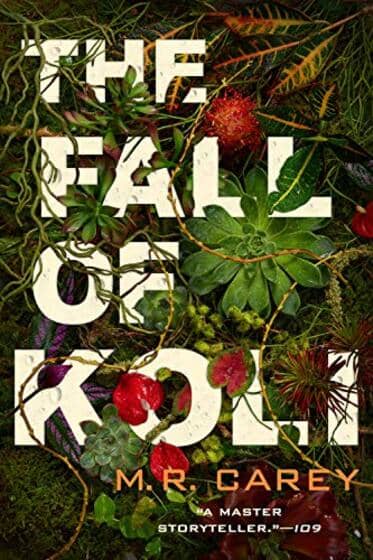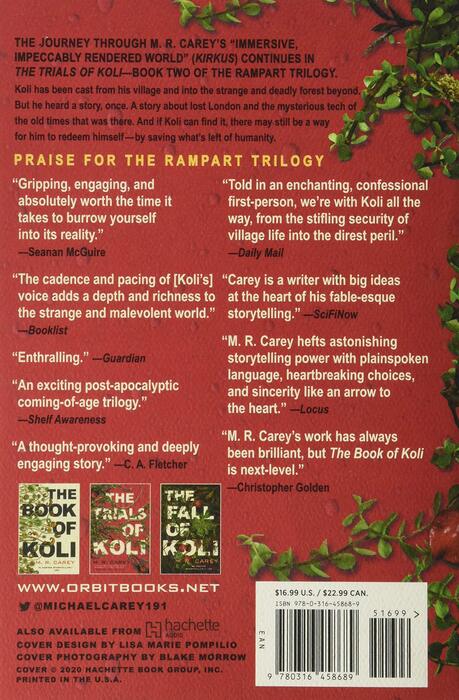Adventure in the Final Days of Civilization in the British Isles: The Trials of Koli by M.R. Carey
 |
 |
 |
The Rampart Trilogy by M.R. Carey, all published by Orbit: The Book of Koli (April 2020),
The Trials of Koli (September 2020), and the forthcoming The Fall of Koli (March 2021). Cover designs by Lisa Marie Pompilio
Post-apocalyptic reading doesn’t seem the best thing for these times of global pandemic and a presidential term that’s seen the US move backward on almost every progressive climate policy. And yet as I explained in my review of The Book of Koli, M. R. Carey has managed to create an enjoyable post-apocalyptic quest through the voice of his flawed, compelling, imminently likeable narrator, Koli. The Trials of Koli, released in September, picks up right where Book 1 left off, with Koli and his companions traveling across an ecologically transformed England in the wake of civilization to find the source of a signal that might mean a semblance of technology and government remaining in London.
Of course, a quest is only as good as those you travel with, and in this Koli is fortunate. Besides the traveling medicine woman Ursula, who carries some of the country’s last viable medical technology, and the sentient Dreamsleeve Mono, an advanced music player that has become Koli’s closest friend, the character who shines in this volume is Cup, a vagabond picked up as captive after a tussle with a cannibalistic cult at the end of the first volume. Cup becomes an ally and companion in this second volume, and with her character Carey is able to explore what life might be like for “crossed,” or transgendered, individuals in this new world.
Besides navigating the spectrum of hatred to acceptance that Cup elicits as they travel through various villages, Cup’s identity provides a point of conflict within the company. Ursula, with her access to medical technology, must decide if it’s ethical to give Cup the hormone-blocking treatment she wants to postpone the onset of puberty, even though the therapy for full gender transition is no longer available. This conflict isn’t a major plot point, but it’s integral to the heroes’ journey and a nuanced depiction of a transgendered character. Of course, at the same time our heroes are navigating this they’re also figuring out how to deal with the coming seed-fall of a forest full of carnivorous trees.
[Click the images for apocalypse-sized versions.]
 |
 |
Back covers for The Book of Koli and The Trials of Koli
Besides sympathetic characters in a realized landscape, a second major aspect of this book that stands out: the characters Koli left behind. In the first book, Koli was driven out of his village of Mythen Rood because he stole forbidden tech in an attempt to make himself a Rampart, one of the ruling caste, and win back the affection of his childhood sweetheart, Spinner. From the first book, it seemed the narrative would follow Koli alone as he found his way in the wide world and then returned to save his dying village and maybe even win back Spinner. But in this second volume Carey turns these expectations on their head by splitting the narrative between Koli’s quest and what’s happening back in Mythen Rood, seen through Spinner’s eyes. Far from sitting around waiting to be rescued, Spinner succeeds where Koli failed. Asked by a Rampart to help understand what’s causing a plague in the village, Spinner finds knowledge regarding the past and in the process reactivates the most powerful tech Mythen Rood has ever seen: an AI-driven battle tank from the final wars.
The irony here is lovely: where Koli was banished for stealing what is basically a self-aware iPod, Spinner ends up gaining far more powerful tech. Far from Koli returning in triumph to their village, it’s looking more likely that the village will come to save him. At the very least, the relationships and stakes have grown in complexity, and Koli’s homecoming — anticipated in the third volume The Fall of Koli, scheduled for release next March — will certainly not be as straightforward as him returning as Mythen Rood’s savior.
The book races to a satisfying conclusion. The carnivorous forests, which were more of a background threat in the first novel, take a more active role here, as Koli and his friends have to brace for the fall of choker seeds, which bury themselves wherever they land, including and most especially in exposed flesh. By the book’s end, Koli and party have arrived at the source of the signal they’ve been tracking for the first two volumes, and whatever they find, it’s clear that Koli’s going to learn what happened in the final days of civilization in the British Isles and whether there are enough pieces to put back together.
Stephen Case has published fiction at Beneath Ceaseless Skies, Orson Scott Card’s Intergalactic Medicine Show, and Daily Science Fiction. His reviews have appeared at Fiction Vortex and Strange Horizons, as well as his own blog, stephenreidcase.com. His last review for us was A Declaration of the Rights of Magicians by H.G. Parry.
[…] about them here, as I spelled out what I loved in reviews of the first one here and the second one there, other than to say I’m eagerly anticipating the final installment in […]